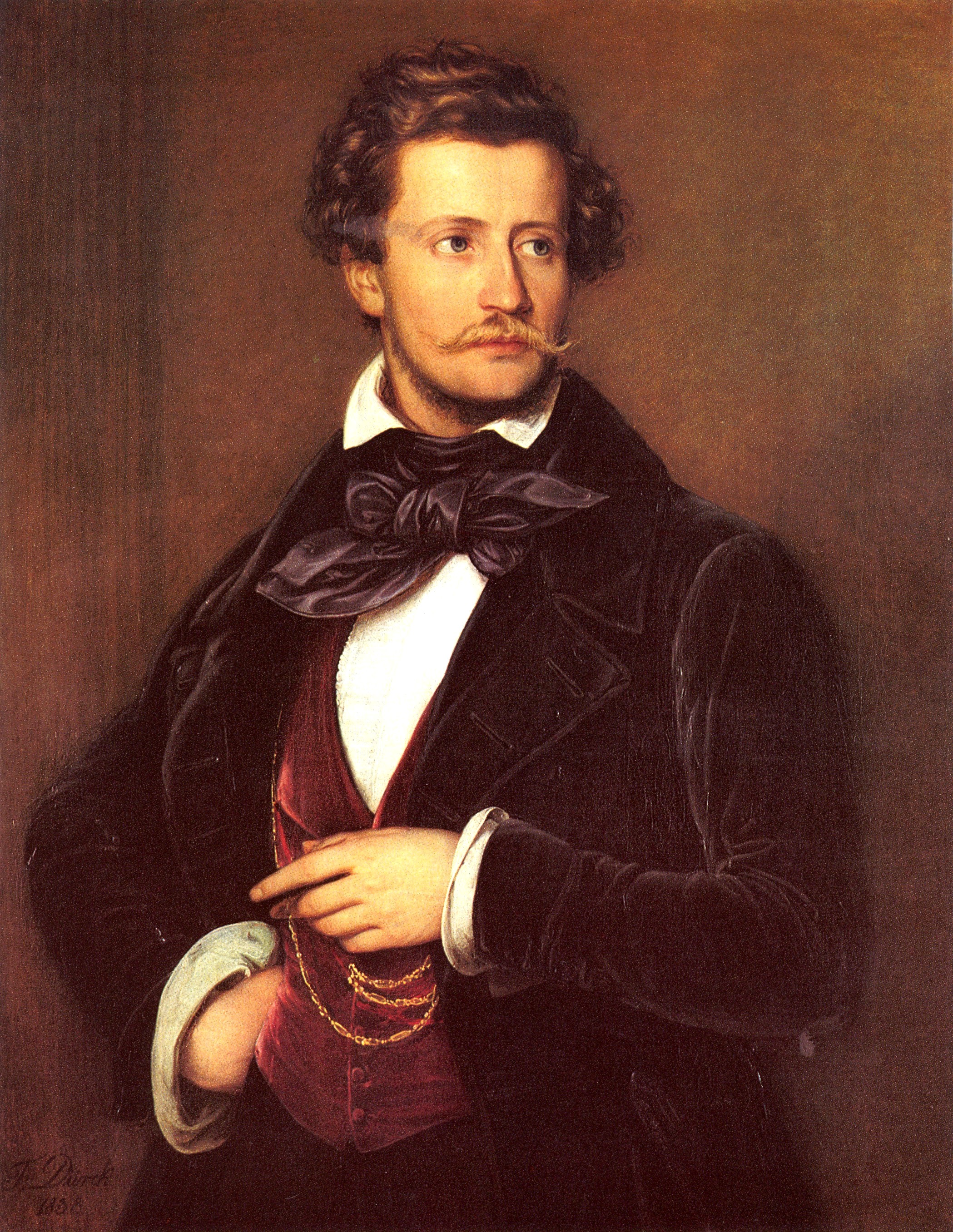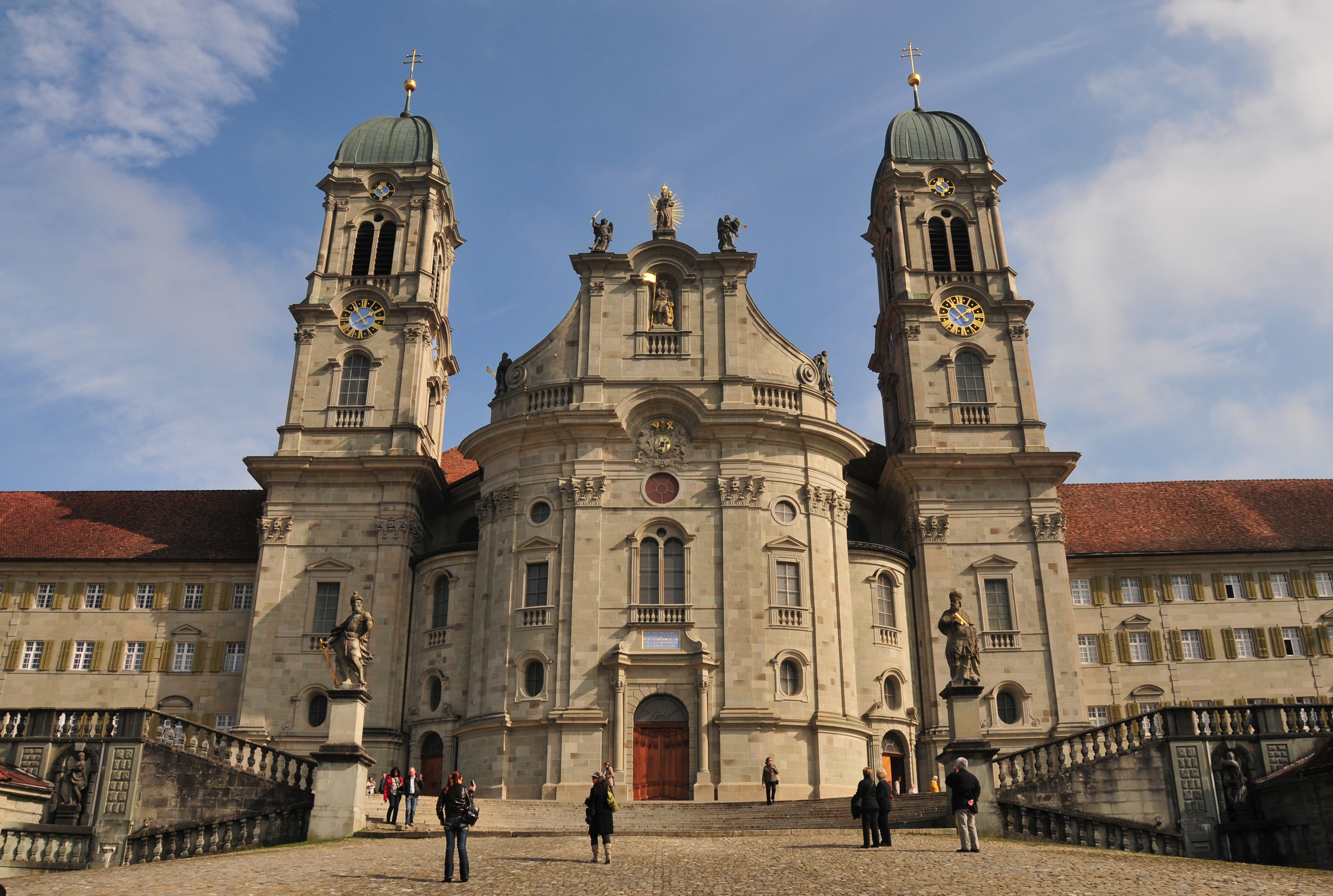|
Bruno Piglhein
Elimar Ulrich Bruno Piglhein (19 February 1848, in Hamburg – 15 July 1894, in Munich) was a German sculptor and painter. He was a founder and first President of the Munich Secession. Life His father was a decorator. Upon graduating from the Gymnasium, he studied with the sculptor Julius Lippelt. After Lippelt's death from tuberculosis, Piglhein went to the Dresden Academy of Fine Arts, but had to leave after two years for an alleged lack of talent. The sculptor Johannes Schilling saw that he had some potential, however, and took him into his studio. After a short stay in Italy, Piglhein decided to take up painting instead and, on Schilling's recommendation, began studies with Ferdinand Pauwels at the Weimar Saxon-Grand Ducal Art School. Finding the small town atmosphere uncongenial, in 1871 he moved to Munich, where he became an associate of Wilhelm von Diez. Despite the attention given to his painting of the Crucifixion at the Munich exhibition and the positive critical rece ... [...More Info...] [...Related Items...] OR: [Wikipedia] [Google] [Baidu] |
Franz Hanfstaengl
Franz Seraph Hanfstaengl (1 March 1804, in near Bad Tölz – 18 April 1877, in Munich) was a Bavarian painter, lithographer, and photographer. Life Hanfstaengl originated from a commoner family and in 1816 came on the recommendation of the town-school-teachers into the drawing-class of the leave-day school at Munich led by Hermann Joseph Mitterer. He was instructed in lithography, he had contact with Alois Senefelder and studied from 1819 to 1825 at the Munich Academy of Fine Arts. In 1826, he went to Dresden and began his great work, completed in 1852, of copying in lithograph the canvases of the Dresden Gallery. Between 1835 and 1852 Hanfstaengl brought out about 200 lithographic reproductions of masterworks from the Dresden picture-gallery, and published them in a portfolio. When he returned to Munich, he left his establishment at Dresden to his brothers Max and Hans. In 1833 he founded in Munich a lithographic establishment of his own, which he operated until 1868, and ... [...More Info...] [...Related Items...] OR: [Wikipedia] [Google] [Baidu] |
Crucifixion Of Christ
The crucifixion and death of Jesus occurred in 1st-century Judea, most likely in AD 30 or AD 33. It is described in the four canonical gospels, referred to in the New Testament epistles, attested to by other ancient sources, and considered an established historical event. There is no consensus among historians on the details.Christopher M. Tuckett in ''The Cambridge companion to Jesus'' edited by Markus N. A. Bockmuehl 2001 Cambridge Univ Press pp. 123–124 In the canonical gospels, Jesus is arrested and tried by the Sanhedrin, and then by Pontius Pilate, who sentences him to flagellation and finally crucifixion by the Roman Empire.''The Cradle, the Cross, and the Crown: An Introduction to the New Testament'' by Andreas J. Köstenberger, L. Scott Kellum 2009 pp. 104–108Evans, Craig A. (2001). ''Jesus and His Contemporaries: Comparative Studies'' p. 316 Jesus was stripped of his clothing and offered vinegar mixed with myrrh or gall (likely posca), to ... [...More Info...] [...Related Items...] OR: [Wikipedia] [Google] [Baidu] |
19th-century German Painters
The 19th (nineteenth) century began on 1 January 1801 ( MDCCCI), and ended on 31 December 1900 ( MCM). The 19th century was the ninth century of the 2nd millennium. The 19th century was characterized by vast social upheaval. Slavery was abolished in much of Europe and the Americas. The First Industrial Revolution, though it began in the late 18th century, expanding beyond its British homeland for the first time during this century, particularly remaking the economies and societies of the Low Countries, the Rhineland, Northern Italy, and the Northeastern United States. A few decades later, the Second Industrial Revolution led to ever more massive urbanization and much higher levels of productivity, profit, and prosperity, a pattern that continued into the 20th century. The Islamic gunpowder empires fell into decline and European imperialism brought much of South Asia, Southeast Asia, and almost all of Africa under colonial rule. It was also marked by the collapse of the l ... [...More Info...] [...Related Items...] OR: [Wikipedia] [Google] [Baidu] |
German Male Sculptors
German(s) may refer to: * Germany (of or related to) **Germania (historical use) * Germans, citizens of Germany, people of German ancestry, or native speakers of the German language ** For citizens of Germany, see also German nationality law **Germanic peoples (Roman times) * German language **any of the Germanic languages * German cuisine, traditional foods of Germany People * German (given name) * German (surname) * Germán, a Spanish name Places * German (parish), Isle of Man * German, Albania, or Gërmej * German, Bulgaria * German, Iran * German, North Macedonia * German, New York, U.S. * Agios Germanos, Greece Other uses * German (mythology), a South Slavic mythological being * Germans (band), a Canadian rock band * "German" (song), a 2019 song by No Money Enterprise * ''The German'', a 2008 short film * "The Germans", an episode of ''Fawlty Towers'' * ''The German'', a nickname for Congolese rebel André Kisase Ngandu See also * Germanic (disambiguation ... [...More Info...] [...Related Items...] OR: [Wikipedia] [Google] [Baidu] |
19th-century German Sculptors
The 19th (nineteenth) century began on 1 January 1801 ( MDCCCI), and ended on 31 December 1900 ( MCM). The 19th century was the ninth century of the 2nd millennium. The 19th century was characterized by vast social upheaval. Slavery was abolished in much of Europe and the Americas. The First Industrial Revolution, though it began in the late 18th century, expanding beyond its British homeland for the first time during this century, particularly remaking the economies and societies of the Low Countries, the Rhineland, Northern Italy, and the Northeastern United States. A few decades later, the Second Industrial Revolution led to ever more massive urbanization and much higher levels of productivity, profit, and prosperity, a pattern that continued into the 20th century. The Islamic gunpowder empires fell into decline and European imperialism brought much of South Asia, Southeast Asia, and almost all of Africa under colonial rule. It was also marked by the collapse of ... [...More Info...] [...Related Items...] OR: [Wikipedia] [Google] [Baidu] |
1894 Deaths
Events January–March * January 4 – A military alliance is established between the French Third Republic and the Russian Empire. * January 7 – William Kennedy Dickson receives a patent for motion picture film in the United States. * January 9 – New England Telephone and Telegraph installs the first battery-operated telephone switchboard, in Lexington, Massachusetts. * February 12 ** French anarchist Émile Henry sets off a bomb in a Paris café, killing one person and wounding twenty. ** The barque ''Elisabeth Rickmers'' of Bremerhaven is wrecked at Haurvig, Denmark, but all crew and passengers are saved. * February 15 ** In Korea, peasant unrest erupts in the Donghak Peasant Revolution, a massive revolt of followers of the Donghak movement. Both China and Japan send military forces, claiming to come to the ruling Joseon dynasty government's aid. ** At 04:51 GMT, French anarchist Martial Bourdin dies of an accidental detonation of his ow ... [...More Info...] [...Related Items...] OR: [Wikipedia] [Google] [Baidu] |
1848 Births
1848 is historically famous for the Revolutions of 1848, wave of revolutions, a series of widespread struggles for more classical liberalism, liberal governments, which broke out from Brazil to Hungary; although most failed in their immediate aims, they significantly altered the political and philosophical landscape and had major ramifications throughout the rest of the century. Ereignisblatt aus den revolutionären Märztagen 18.-19. März 1848 mit einer Barrikadenszene aus der Breiten Strasse, Berlin 01.jpg, Cheering German revolutions of 1848–49, revolutionaries in Berlin, on March 19, 1848, with the new flag of Germany Lar9 philippo 001z.jpg, French Revolution of 1848: Republican riots forced King Louis-Philippe to abdicate Zeitgenössige Lithografie der Nationalversammlung in der Paulskirche.jpg, Frankfurt Parliament, German National Assembly's meeting in St. Paul's Church Pákozdi csata.jpg, Battle of Pákozd in the Hungarian Revolution of 1848 Events January ... [...More Info...] [...Related Items...] OR: [Wikipedia] [Google] [Baidu] |
Academy Of Fine Arts Munich
The Academy of Fine Arts, Munich (german: Akademie der Bildenden Künste München, also known as Munich Academy) is one of the oldest and most significant art academies in Germany. It is located in the Maxvorstadt district of Munich, in Bavaria, Germany. History The history of the academy goes back to the 18th century, before the 1770 founding by Elector Maximilian III. Joseph, the so-called "drawing school", which already bore the name "academy" in its name ("Zeichnungs Schule respective Maler und Bildhauer academie"). The Academy of Fine Arts was enhanced in 1808 by King Maximilian I Joseph of Bavaria as Royal Academy of Fine Arts. The Munich School refers to a group of painters who worked in Munich or were trained at the Academy between 1850 and 1918. The paintings are characterized by a naturalistic style and dark chiaroscuro. Typical painting subjects included landscape, portraits, genre, still-life, and history. From 1900 to 1918 the academy's director was Ferdinand Fr ... [...More Info...] [...Related Items...] OR: [Wikipedia] [Google] [Baidu] |
Cyclorama Of Jerusalem
The Cyclorama of Jerusalem is located in Sainte-Anne-de-Beaupré, Quebec, near the Basilica of Sainte-Anne-de-Beaupré. It is a cyclorama, a circular painting, of the Crucifixion of Jesus, showing what the city of Jerusalem might have looked like at the time of his death. History The cyclorama has been on display since 1895. It was painted by Paul Philippoteaux, the panoramist from Paris, assisted by five other painters: Salvador Mège (1854–1915) and Ernest Gros, of Paris, Charles Abel Corwin and Oliver Dennett Grover, of Chicago and Edward James Austen (1850–1930), of London. The Cyclorama is one of the world's largest. It measures . Among the scenes are: The South section of Jerusalem and the Tomb of Absalom. The Cyclorama was declared as a ''bien patrimonial'' (heritage property/item) by the government of Quebec in August 2017. The family that owned the Cyclorama had been trying to sell it; the designation doesn't prevent the sale but gives the government the right o ... [...More Info...] [...Related Items...] OR: [Wikipedia] [Google] [Baidu] |
Einsiedeln
Einsiedeln () is a municipality and district in the canton of Schwyz in Switzerland known for its monastery, the Benedictine Einsiedeln Abbey, established in the 10th century. History Early history There was no permanent settlement in the area prior to the early medieval period, but numerous artefacts left by prehistoric hunters, dated to the Mesolithic to Bronze Age were recovered. The original " hermitage" is associated with St. Meinrad, a Benedictine monk family of the Counts of Hohenzollern. According to legend, Meinrad lived on the slopes of Mt. Etzel from 835 until his death in 861. During the next eighty years Saint Meinrad's hermitage was never without one or more hermits emulating his example. One of the hermits, named Eberhard, previously Provost of Strasburg, erected a monastery and church there, of which he became first abbot. Work on the monastery is said to have begun in 934. [...More Info...] [...Related Items...] OR: [Wikipedia] [Google] [Baidu] |
Josef Block
Josef Block (27 November 1863 – 20 December 1943) was a German painter. Life and career Block was born in Bernstadt an der Weide (Bierutów) in Prussian Silesia. He was a scholar of the Breslau (Wrocław) Art Academy, where his lifelong friendship with German dramatist Gerhart Hauptmann was established. He continued his studies at the Munich Academy of Fine Arts; in the studio of his tutor Professor Bruno Piglhein, Block was involved in painting Piglhein's Jerusalem Panorama. at www.prof-bruno-piglhein.de On 29 February 1892, the Society of Visual Artists of Munich was founded in his studio at Munich's [...More Info...] [...Related Items...] OR: [Wikipedia] [Google] [Baidu] |








